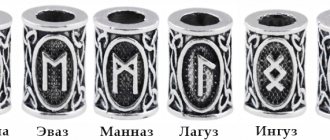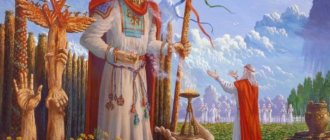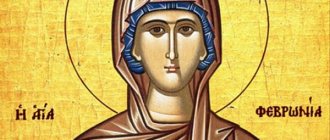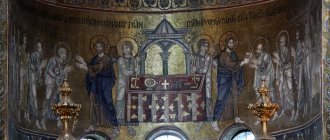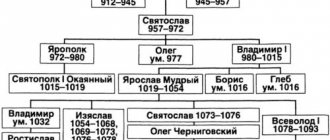Early years
To find the answer to the question “Who is Nestor the Chronicler?”, it is necessary to track the biography of the historical character. Unfortunately, he lived in those distant times about which little is currently known. An important role was played by the fact that Nestor, like a true monk, led a solitary lifestyle.
Presumably, Nestor was born in 1056, on White Lake. Apparently, his family was quite wealthy, since the boy received a decent education, which at that time was a sign of special social status and wealth.
Canonization and history of relics
Nestor's spirituality and desire for unity with the Lord became the basis for his canonization not only in the Russian Orthodox Church, but also in the Catholic Church. At the beginning of the 19th century. A gilded tablet with his name appeared at the burial site of the reverend husband.
Relics of Nestor the Chronicler in the Kyiv-Pechersk Lavra
The relics of Saint Nestor are kept in the lower cave city of Anthony of Pechersk. In numerous illuminated caves there are crayfish, where the relics of saints are kept. Above each burial there is a plaque with the name of God's saint and the date of his burial.
People who want to strengthen their spirit and achieve success in their studies and scientific activities come to the relics of Saint Nestor. There are many testimonies of miracles occurring through prayer at the honest remains of the reverend chronicler.
Chronicles
Nestor is credited with the authorship of at least three works, among which the most significant from a historical and cultural point of view is The Tale of Bygone Years, which covers a large period of time - from biblical times to 1117. Nestor explains where the nationalities came from - Germans, Rus, Varangians and how ancient Russian cities arose, describes the life of Russian princes. A large place in the chronicle is devoted to the topic of Christianity.
The second chronicle of Nestor is called “Reading about the life and destruction of the blessed passion-bearer Boris and Gleb,” or “The Life of Boris and Gleb.”
Boris and Gleb were the sons of Prince Vladimir, who were destined to die at the hands of their half-brother Svyatopolk. Being deeply religious people, the brothers humbly accepted martyrdom from a cruel relative who fought for sole power.
The third chronicle of Nestor - “The Life of Our Reverend Father Theodosius, Abbot of Pechersk”, or simply “The Life of Theodosius of Pechersk” - has partially survived to this day. It tells the story of Theodosius’ life journey, from birth to death.
Angelic Ministry
After the blessed death of Anthony (1073) and Theodosius (1074), he himself seemed to have died to the world.
From the abbot of the Pechersk monastery, Venerable Stephen, Nestor received an angelic image, and soon he was elevated to the rank of hierodeacon.
The monks of the Pechersk Monastery were famous for many virtues. Wanting to imitate the Redeemer, they willingly performed the most difficult daily feats. Some ate only raw or boiled grass, some labored in prayer vigils, some in prostrations. All of them were united by the fact that they unanimously remained in faith, hope, love, as befits the brethren of the Orthodox monastery.
Having adopted an angelic image (double: as a monk and as a deacon), Nestor became like the disembodied heavenly servants: with even greater zeal he began to please God with obedience and prayer, and began to increase Christian virtues in himself. At the same time, he did not hypocritically consider himself a sinner unworthy of God's gifts.
Engaged in ascetic work and experiencing Divine goodness through experience, Nestor did not deny the importance of theoretical knowledge. He valued godly books as a treasury of Truth and allegorically compared them to rivers flooding the universe. It is believed that his special obedience was the compilation of chronicles.
So, in the 80s of the 11th century, he recorded the life of his spiritual teacher, Theodosius of Pechersk. But perhaps the most outstanding creative work of Nestor the Chronicler was the history of the development of the Russian land. It is believed that he completed this work by 1112-1113.
In essence, it included a complex of various legends, processed and presented in the form of a single integral work. Historical facts are closely intertwined in it with the history of the development of the Church. The history of Rus' itself is presented here as an important and integral part of world history. The fundamentality and clarity of the work reveals the author as a man of great learning and faith.
In 1091, the brethren, moved by the Holy Spirit, gathered at the head of the abbot for a council, where, after consulting, they decided to dig up the relics of St. Theodosius, previously buried in a cave, and solemnly transfer them to the Pechersk Church. According to the word of the abbot, Nestor, having prepared the necessary tools, chose assistants from the brethren and headed for the burial of the saint. They said prayers and began to dig. They dug alternately, evening and night; however, it was not possible to get to the honest relics. And only when the bell was struck, at that very moment Nestor suddenly realized that he had gotten to the bottom of the relics.
This event itself was accompanied by a miraculous sign: the brethren in the monastery saw pillars of fire. The relics were reverently transferred to the prepared place. Subsequently, Nestor witnessed other miracles and signs performed by the power of God through this shrine.
Having achieved, with the help of God, holiness and reverence, Nestor peacefully rested in the Lord in 1114, bequeathing to his brethren to continue the chronicle of the history of Rus' compiled by him, which was fulfilled. In its modern form, this chronicle is known to us by its name: The Tale of Bygone Years.
In addition, other works of the Chronicler have reached us, for example: The Legend of the Saints of the First Monarchs of Pechersk, The Word of the Transfer of the Relics of Our Rev. Father, Theodosius of Pechersk, The Legend of What gave the Pechersky Monastery its name.
Memory
Nestor lived a long pious life, leaving a significant mark on history. After his death, the chronicler was buried in the caves of the Kiev Pechersk Monastery, and was later canonized by the Russian Orthodox Church as a saint. In addition, Nestor is included in the list of saints of the Roman Catholic Church. The monk's memorial day is celebrated on November 9.
Monuments to Nestor the Chronicler are located in Kyiv, Vladimir, Boryspil. In the saint’s native monastery, two churches named after the saint were erected.
Full biography - Nestor the Chronicler
Nemstor (c. 1056 - 1114) - Old Russian chronicler, hagiographer of the late 11th - early 12th centuries, monk of the Kiev Pechersk Monastery.
Traditionally considered one of the authors of the “Tale of Bygone Years”, which, along with the “Czech Chronicle” by Cozma of Prague and the “Chronicle and Acts of the Princes or Rulers of the Polish” by Gall Anonymous, is of fundamental importance for Slavic culture.
The text of the “Tale of Bygone Years” as part of the Ipatiev Chronicle begins with an unnamed mention of its author - the monk of the Pechersk Monastery, and in the message of another Pechersk monk, Polycarp, to Archimandrite Akindinus, dating from the 13th century, Nestor is directly indicated as the author of the Initial Chronicle. The same thing is said in the “Life of St. Anthony,” compiled somewhat later and based on oral monastic traditions.
From the Tale of Bygone Years itself it is known that at the end of the 11th century. Nestor lived in the Pechersky monastery: talking about the Polovtsian raid on the Pechersky monastery in 1096, he says: “... and when we came to the Pechersky monastery, we lived in our cells, resting after matins.” It is also known that the chronicler was still alive in 1106: in this year, he writes, the good old man Ian died, “from him I heard many words that were written in these chronicles.” There is no more reliable information about him.
It is believed that Nestor also wrote “Reading about the life and destruction of Boris and Gleb”, “The Life of Theodosius of Pechersk”, “The Legend of Belgorod jelly”.
Canonized (Reverend Nestor the Chronicler) in the Russian Orthodox Church; memory - July 27 according to the Julian calendar. The relics rest in the Near (Antonie) caves of the Kiev Pechersk Lavra.
Rev. Nestor the Chronicler was born in the 50s of the 11th century in Kyiv. As a young man he came to Rev. Theodosius and became a novice. The future chronicler's successor, Rev., was tonsured. Theodosius, Abbot Stefan. According to the Greek church rule, those entering the monastery remain on probation for three years, and those ordained as a deacon must be at least 25 years old. And Rev. Theodosius established: do not rush to tonsure the applicant as a monk, but order him to wear his own clothes until he becomes familiar with the monastic rites. After this, dress him in black clothes and test him with obedience, and then clothe him in a monastic robe. So for blessed Nestor, the three-year trial ended already under the Venerable. Stephen, under whom he was awarded the rank of deacon, not earlier than 1078.
In the Pechersk monastery there were then many high men from whom one could learn spiritual perfection. The monastery then flourished with spiritual life. Blessed Nestor writes about it himself:
“When Stefan ruled the monastery and the blessed flock that Theodosius gathered, the Chernets shone like stars in Rus'. Some were strong teachers, others were steadfast in vigil or kneeling prayer; some fasted every other day and every other two days, others ate only bread and water, others - boiled potion, others - only raw. Everyone was in love: the younger ones submitted to the elders, not daring to speak in front of them and expressing complete submission and obedience; and the elders showed love to the younger ones, instructed and consoled them, like fathers of small children.
If any brother fell into any sin, they consoled him and, out of great love, divided the penance of one into two or three. Such was mutual love, with strict abstinence! If a brother left the monastery, then all the brethren grieved for him, sent for him and called his brother to the monastery, then they went to the abbot, bowed and begged to accept their brother, and received him with great joy.”
Blessed Nestor the Chronicler, under the influence of such examples, under the guidance of such mentors, with his zeal for asceticism, hastily grew in spiritual life. How deeply his humility was, this is evident every time he touches on his personality in his writings. He does not call himself otherwise than the bad, unworthy, sinful Nestor, the least of all in the monastery of the Venerable Father Theodosius; or the accursed one, with a rude and unreasonable heart, the sinful Nestor.
If he reminds others of the need for repentance, of the need to remember their relationship to God, then he hastens to turn to himself with reproach. Thus, having told about the victory of the Polovtsians, which followed on the eve of the memory of St. Boris and Gleb, he says: “there was weeping in the city, and not joy, for our sin... For the sake of our bliss, we were executed. Behold, I am a sinner and I sin much and often all the days.”
With the purity of his life, prayer and zeal, the young ascetic soon surpassed even the most famous Pechersk elders. And his high spiritual life is also indicated by the fact that he, along with other reverend fathers, participated in the exorcism of the demon from Nikita the recluse (later the Novgorod saint).
Being a monk in the Middle Ages did not mean being isolated from the world. The Studio Charter, which was introduced in Rus' (and in particular in the Pechersk Monastery), even obliged the monks to found libraries, educational institutions, hospitals, almshouses and other structures, the purpose of which was to satisfy all kinds of public needs. Nestor was not a calm contemplator of what was happening around him.
His first works belong to the hagiographic genre. The story of the beginning of the Pechersk Monastery, the story of the Pechersk ascetics and “The Life of Theodosius of Pechersk” are distinguished by their vivid depiction of monastic life and vivid characteristics of the monks and laity. At the end of the 12th century. Nestor wrote “The Tale of the Life and Death of the Blessed Passion-Bearers Boris and Gleb,” where he condemned the war between the brothers and depicted a picture of their martyrdom. But his main work was “The Tale of Bygone Years” - the greatest monument of ancient Russian historical literature.
It is known that chronicle writing was one of the brightest manifestations of the literary heritage of Kievan Rus. We have a brilliant historiographical heritage, represented by a whole galaxy of outstanding names. And Nestor, without a doubt, takes first place among them. His name as the compiler of the “Tale” is named in the later Khlebnikov list of this work (XVI century). The “Kievo-Pechersk Patericon,” among the monks who lived in the Pechersk Monastery in the 11th century, names Nestor, “who was written by the chronicler.” This “chronicler” could only be “The Tale of Bygone Years.” The text preserves places where the chronicler speaks for himself. Analysis of such places allows us to attribute them specifically to Nestor.
Nestor’s chronicle begins with the words that give the name to the entire work: “Here is the tale of bygone years, where the Russian land came from, who began to reign first in Kyiv, and where the Russian land came from.” “The Tale” was created in accordance with the canons of world medieval historiography. It is based on the so-called Initial Summary, written around 1095 in the Pechersk Monastery, which began with a short story about the founding of Kyiv by the Polyan brothers Kiy, Shchek and Khoriv. The author prefaced this story with an extensive historical and geographical introduction, which describes the origin and ancient history of the Slavs and gives a picture of their settlement in the vast expanse of Europe.
The chronicler depicted the history of the peoples neighboring Russia based on the Byzantine chronicle of George Amartol, and when writing the history of the Eastern Slavs he used folklore sources. He supplemented the dry and brief information about the first Russian princes, collected by his predecessors, with picturesque details borrowed from folk tales and squad songs, in particular, stories about how Oleg besieged Constantinople and was killed by his horse; how Olga avenged her husband’s death; how Svyatoslav went on campaigns; how the Kozhemyaka youth defeated the Pecheneg hero, etc. At the same time, Nestor was critical of his sources: he compared different versions of events, discarding those that seemed erroneous to him, and confirming the plausible ones. For example, he discarded the legend according to which Kiy was a simple carrier on the Dnieper, the version of the Kiev baptism of Vladimir, the so-called chronology of Jacob Mnich, etc.
The chronicle contains important documentary materials - the texts of agreements between princes Oleg, Igor and Svyatoslav with the Greeks, as well as documents from the grand ducal archive, which gave the author the opportunity to realistically depict the political history of Ancient Rus'. The Tale of Bygone Years contains such literary works as the “Teaching” of Vladimir Monomakh, the story of the blinding of Vasilko Terebovlyansky, as well as Byzantine and Western European written monuments. In 1107, Nestor visited the Vladimir-Volynsky and Zimnensky Svyatogorsky monasteries. The result of the trip was the almost complete inclusion of the Volyn Chronicle in the Tale of Bygone Years.
But the main thing in “The Tale” is that this work, being a chronological presentation of historical events in Rus', at the same time responded to the painful social problems of the author’s contemporary life. Nestor lived in difficult times, when feudal fragmentation began in Rus' and the princes plunged into internecine wars. Nestor witnessed the initial stages of this process. Grandiose strife took place before his eyes in 1078, 1096, 1097. The state gradually lost its former power; The Polovtsian hordes, taking advantage of his difficult situation, devastated the border lands. The author contrasts the selfishness and greed of the princes and boyars, their disregard for all-Russian interests with the idea of East Slavic unity, calling on the people of Rus' to unite in the face of the threat of external danger and defend their land.
For residents of Kievan Rus at the beginning of the 12th century. “The Tale” was a book about modernity and contemporaries. A significant part of her characters were still alive and one way or another had to react to the content of the work. Some scientists accuse the author of the “Tale” of being an adherent of the Kyiv prince Svyatopolk Izyaslavich (1093–1113), pleasing his patron in every possible way and “molding” from historical facts only what he liked. This opinion is not unfounded, but Nestor should not be blamed. As is known, chronicle writing in Rus' was placed at the level of state affairs. And although chronicles, as a rule, were created in monasteries, they passed through the princely office, and more often the princes themselves acted as customers.
Nestor the Chronicler completed his outstanding work around 1113. The chronicle of events in the “Tale” was completed until 1110. Unfortunately, Nesterov’s edition of the “Tale” was not preserved in its original form. After the death of Svyatopolk Izyaslavich (1113), who took care of the Kiev-Pechersk Monastery, Vladimir Monomakh ascended to the Kiev table. He came into conflict with the top of the monastery and transferred the chronicle to the Vydubitsky monastery founded by his father Vsevolod. In 1116, the Vydubitsky abbot Sylvester redid the final articles of the Tale, positively assessing the activities of Vladimir Monomakh, showing him as a wise prince, defender of the Russian land. This is how the second edition appeared. In 1118, the third edition was created, which has reached our time. The customer and, possibly, one of its authors was the son of Monomakh, Prince Mstislav. “The Tale of Bygone Years” has been preserved in many lists. The oldest of them are Lavrentievsky (1377) and Ipatievsky (beginning of the 15th century).
Nestor's main historical merit is that he created a historical and artistic work that had no analogues in European medieval historiography. Showed that our people have their own history that they can be proud of.
The Monk Nestor died around 1114, bequeathing to the Pechersk monks-chroniclers the continuation of their work. His successors in the chronicles were Abbot Sylvester, who gave a modern look to the “Tale of Bygone Years”, Abbot Moisei Vydubitsky, who extended it until 1200, and finally, Abbot Lavrenty, who in 1377 wrote the oldest copy that has come down to us, preserving the “Tale” of St. Nestor ( "Laurentian Chronicle"). The heir to the hagiographic tradition of the Pechersk ascetic was St. Simon, Bishop of Vladimir, rescuer of the “Kievo-Pechersk Patericon.” When talking about events related to the life of the holy saints of God, Saint Simon often refers, among other sources, to the Chronicles of St. Nestor.
The Monk Nestor was buried in the Near Caves of the Monk Anthony of Pechersk.
Nestor as a miracle worker
Speaking about this great man, one cannot fail to mention one more important detail. Saint Nestor the Chronicler has been revered as a miracle worker since ancient times. As we have already mentioned, together with other monks of the Kiev-Pechersk monastery, he took part in driving out the devil from Nikita the Recluse. The youngest of them, he nevertheless enjoyed great authority among the other brothers.
Cases have been recorded where touching the reliquary with its relics healed various diseases. There is even a story about a child who, by the age of four, practically could not speak. Concerned parents, on the advice of knowledgeable people, carried it and placed it on the shrine with holy relics. And the child began to speak in coherent sentences. Be that as it may, even now people turn to the venerable elder with prayer, asking him to bestow wisdom, help in acquiring knowledge and guide him on the path of salvation.
A truly great ascetic was Nestor the Chronicler. Photos of monuments and paintings with his image convey the depth of his thoughts, the pure light of the divine spark in his eyes. But true wisdom lies in his words and immortal texts, which even now continue to excite the hearts of Orthodox Christians. The story of Nestor the Chronicler is a description of the life of a noble soul, fully endowed with God's fire in order to illuminate the fate of an entire people.
Meaning of the work
The importance of labor cannot be overestimated. This is, without a doubt, the main work that Nestor the Chronicler worked on. “The Tale of Bygone Years” remains the most important source of information on Russian history to this day. Note that not only scientists of past centuries, but also modern researchers continue to draw information from it.
In addition, the work, due to its artistic qualities, has become the largest literary monument. Let us also note that this work is also a significant legal document, since it includes some laws and instructions. “The Tale of Bygone Years” became a treasure trove of information for later fiction.
In particular, the tragedy “Vadim Novgorodsky” by Ya. B. Knyazhnin was built on its basis. The famous “Song of the Prophetic Oleg” by A. S. Pushkin is imbued with the poetry of ancient legends.
The Tale of Bygone Years played a significant role in the creation of later regional chronicles. She was constantly included in them, starting with the history of Tver, Novgorod, and also the Moscow state.
The colossal educational role of the work cannot be underestimated. From generation to generation, it teaches patriotism and pride in one’s people and respect for its glorious history.
With all this, Nestor’s merit primarily lies in the fact that, unlike most monks who tried to embellish events in every possible way, he presented only the facts. Like Herodotus, the historian wanted to capture the true life of his people, customs, traditions, and way of life.
Thanks to this work, we can judge not only the great exploits of the princes, but also their character. We know a lot about the palace intrigues and secrets of that time.
The Tale of Bygone Years
But the most important work that the Monk Nestor the Chronicler created was the “Tale of Bygone Years” compiled in 1112-1113. Let us note that before its appearance, Russian culture did not know such works. The existing records were fragmentary and could not provide a complete picture of the historical events taking place in Rus'.
“The Tale of Bygone Years” is an integral, unified, global work, and therefore its author is deeply revered as the first chronicler. Nestor conceived a colossal task - to bring together scattered lists, records and historical records. Therefore, it includes not only his personal writings, but also the works of his predecessors. “The Tale of Bygone Years” can be called one of the main sources on the ethnography of the Eastern European peoples of that time. It contains information about the life, language and beliefs of various Slavic tribes.
The story is heterogeneous: in addition to the detailed descriptive part, it also contains the lives of saints, folk poetic legends, historical notes and other inserted materials that Nestor immortalized in his work. The Russian chronicler first tells the story of biblical times and the separation of the Slavs into a separate nation. Afterwards we talk about numerous tribes, as well as the emergence and fate of our state right up to the very beginning of the 12th century.
The history of Ancient Rus' is organically woven into the global one, becoming its integral component. From the chronicle we draw information about the reign of the Ruriks, about the life of the first great princes. Much attention is paid to the lengthy biographies of saints, as well as various historical events - wars, battles, campaigns.
One of the central places in the work is given to the choice of faith and the baptism of Rus'. We can say that the “Tale” is imbued with Christian ideas and motives, which is not surprising, especially considering that its author was a monk. The meaning of the baptism of Rus' in the work is salvation from pagan ignorance and idolatry. The Tale of Bygone Years pays great attention to various miraculous phenomena - first of all, heavenly signs.
In addition to rich historical information, the work also contains the author's thoughts on the topic of good and evil. Here Nestor reveals himself not only as a researcher and patriot, but also as an extraordinary thinker and philosopher.
Later, The Tale of Bygone Years became a source for further chronicles. As we see, a truly grandiose work was conceived and accomplished by Nestor the Chronicler. His brief biography, reflected in the narrative, although incomplete, still sheds light on the character of the author himself. Notable in this regard are the passages where Nestor has to talk about himself. In them he calls himself unworthy, sinful, and bad. And, probably, they are not only a tribute to the time, which requires such authorial characteristics, but also an indicator of Nestor’s humility and modesty.
